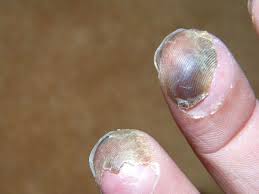This is a type of an injury that is caused by freezing of the skin and the underlying tissues. First, the skin becomes very cold and red. Then, the skin becomes numb, hard and pale. Frostbite is most common on chin, cheeks, ears, nose, toes and fingers. It is known that the exposed skin in cold and windy weather is most vulnerable to frostbite. But you should know that the frostbite can happen on skin that is covered by gloves or other clothing. The first stage of frostbite is the frostnip and this stage does not cause permanent skin damage. The very mild frostbite can be treated with first – aid measures in which re-warming the skin is also included. But all other stages of frostbites need medical attention because it can damage your skin, muscle, tissues and bones. Nerve damage and infection are possible complications of severe frostbite [1].
Frostbite symptoms
Here are some signs and symptoms of frostbite [1]:
- Blistering after re-warming, in severe cases
- Clumsiness due to joint and muscle stiffness
- Hard or waxy – looking skin
- Red, white, bluish – white or grayish – yellow skin
- Numbness
- At first, cold skin and a prickling feeling
The frostbite is most common on the chin, cheeks, ears, nose, toes and fingers. Because of the skin numbness, someone will not realize that he or she has frostbite until someone else points it out. The frostbite is happening in several stages:
- Frostnip: This is the first stage of frostbite. When you are having this mild form of the frostbite, then you skin pales or turns red and it feels very cold. The continued exposure to cold and windy weather can lead to prickling and numbness in the affected area. As your skin is getting warm, you can feel pain and tingling. This stage of the frostbite does not permanently damage your skin. [1]
- Superficial frostbite: This is the second stage of frostbite and it appears as reddened skin which is turning white or pale. Your skin can remain soft but some ice crystals can form in the tissue. Also your skin may begin to feel warm, which is a sign of serious skin involvement. If you are treating this stage of the frostbite with re-warming, then the surface of your skin can appear mottled, purple or blue. Also you can notice swelling, burning and stinging. Also the fluid – filled blister can appear 24 – 36 hours after re-warming the skin. [1]
- Severe (deep) frostbite: As this condition progresses, it can affect all layers of your skin in which are included tissues that lie below. Also you can experience numbness, losing all sensation of cold and the pain or discomfort in the affected area. Muscles or joints may no longer work. Large blisters are forming 24 – 48 hours after re-warming. Afterward, your skin area will turn black and hard as the tissue dies. [1]
Frostbite causes
This condition is happening when the skin and underlying tissues freeze. The exposure to cold – weather conditions is the most common cause for the frostbite. But also frostbites can be also caused by direct contact with freezing metals, ice or very cold liquids [2]. There are some specific conditions which can lead to frostbite such as
- Touching materials such as frozen metal, cold packs or ice [2]
- When you staying out in the cold and wind too long. The risk is increasing as the air temperature falls below 5 F (minus 15 C) even if there is a low wind speed. Also in the wind chill of minus 16.6 F (minus 27 C), the frostbite can happen on exposed skin in less than 30 minutes. [3]
- Wearing clothing that is not suitable for the conditions you are in, for example, it does not protect against wet, windy or cold weather or it is too tight [4,5].
Risk factors: Here are some factors which are increasing the risk of frostbite:
- Being at high altitude, which reduces the oxygen supply to your skin [5]
- Fear, panic or mental illness, if it inhibits good judgment or hampers your ability to respond to cold
- Smoking [6]
- Alcohol or drug abuse [7]
- Being an infant or older adult, both of whom may have a harder time producing and retaining the body heat
- Medical conditions that affect your ability to feel or respond to cold, such as poor blood flow in your limbs, diabetes, exhaustion and dehydration
References:
[1] Lorentzen AK, Davis C, Penninga L. Interventions for frostbite injuries. Cochrane Database of Systematic Reviews. 2018;2018(3):CD012980.
[2] Starzl TE. Treatment of frostbite today. Consultant. 1967;7(1):44–7.
[3] Fudge J. Exercise in the cold: Preventing and managing hypothermia and frostbite injury. Sports Health. 2016;8(2):133–9.
[4] Rintamaki H. Predisposing factors and prevention of frostbite. International Journal of Circumpolar Health. 2000;59(2):114-21.
[5] Harirchi I, Arvin A, Vash JH, Zafarmand V. Frostbite: incidence and predisposing factors in mountaineers. British Journal of Sports Medicine. 2005;39:898-901.
[6] Ervasti O, Juopperi K, Kettunen P, et al. The occurrence of frostbite and its risk factors in young men. International Journal of Circumpolar Health. 2004;63(1):71-80.
[7] Freund BJ, O’Brien C, Young AJ. Alcohol ingestion and temperature regulation during cold exposure. Journal of Wilderness Medicine. 1994;5:88-98.





